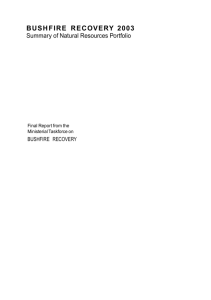MS Word Document - 23.0 KB - Department of Environment, Land
advertisement
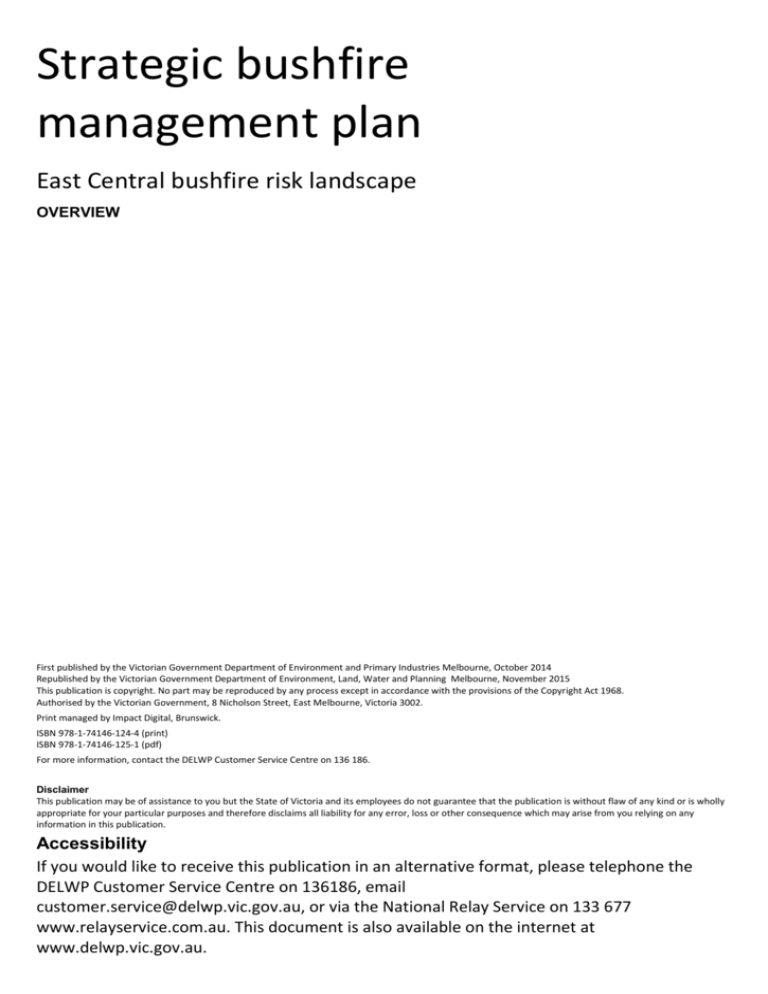
Strategic bushfire management plan East Central bushfire risk landscape OVERVIEW First published by the Victorian Government Department of Environment and Primary Industries Melbourne, October 2014 Republished by the Victorian Government Department of Environment, Land, Water and Planning Melbourne, November 2015 This publication is copyright. No part may be reproduced by any process except in accordance with the provisions of the Copyright Act 1968. Authorised by the Victorian Government, 8 Nicholson Street, East Melbourne, Victoria 3002. Print managed by Impact Digital, Brunswick. ISBN 978-1-74146-124-4 (print) ISBN 978-1-74146-125-1 (pdf) For more information, contact the DELWP Customer Service Centre on 136 186. Disclaimer This publication may be of assistance to you but the State of Victoria and its employees do not guarantee that the publication is without flaw of any kind or is wholly appropriate for your particular purposes and therefore disclaims all liability for any error, loss or other consequence which may arise from you relying on any information in this publication. Accessibility If you would like to receive this publication in an alternative format, please telephone the DELWP Customer Service Centre on 136186, email customer.service@delwp.vic.gov.au, or via the National Relay Service on 133 677 www.relayservice.com.au. This document is also available on the internet at www.delwp.vic.gov.au. The East Central Strategic Bushfire Management Plan outlines the fuel management strategy that the Department of Environment, Land, Water and Planning (DELWP) and Parks Victoria will implement on public land. This strategy guides action to minimise the risk of major bushfires to people, property, infrastructure and economic activity, while maintaining and improving the resilience of natural ecosystems in the East Central Landscape. We have also identified a range of bushfire management actions across prevention, preparedness, response and recovery to complement our fuel management strategy and further reduce bushfire risk. DELWP uses sophisticated computer simulations to tell us where the use of planned burning and other fuel treatment methods is most effective in reducing the risk of bushfire. The simulations show how bushfires spread, based on factors like vegetation, weather and terrain. We can then reduce fuel hazard in the places where the most damaging bushfires are likely to start and spread. By looking at where fires start and spread we can also preposition firefighting personnel and equipment and conduct patrols leading up to and during times of high bushfire danger. By drawing together this information, talking with local stakeholders and using expert knowledge we have developed our fuel management strategy. The strategy identifies priority fuel management areas so that people and properties most at risk will be better protected from bushfire. The placement of these priority areas also considers what effects planned burning will have on ecosystems, plants and animals. There will always be a risk of bushfire in the East Central landscape. While we can never completely eliminate bushfire risk, we can reduce and manage it in many ways. Managing fuel hazard on public land helps to reduce potential impacts; and managing fuel hazard on private land will reduce this even further. To achieve this, DELWP and Parks Victoria work with the Country Fire Authority (CFA), local government and communities to reduce fuel across the landscape based on our modelling of bushfire risk and identify where other strategies to reduce risk are required, while also making sure we understand what communities value. Planned burning helps us to stop small fires from becoming major fires. It also reduces their size, severity and damage potential. Our strategy sets out different ways that we can achieve the best reduction of risk. Actions may include burning around assets (such as towns) for protection, or burning deeper in the forest to slow the momentum and spread of a potential fire. Bushfire risk on private land A large percentage of the overall bushfire risk, and therefore the priority fuel treatment areas, is on private land. We will continue to share information and work with CFA, local governments and other land managers to support action on private land that helps build safer and more resilient communities. Sophisticated and detailed By using the best available information about the landscape to run modelled simulations, we can demonstrate where to prioritise and optimise our fuel treatment efforts. We know where we can get the maximum risk-reduction benefits from fuel management and which areas to exclude from the planned burning program to protect ecosystems and other valuable parts of the landscape. We can also adjust the way we burn, from more gentle burns in sensitive areas to more intense burns where suitable. Native Vegetation The East Central landscape is geologically diverse and complex, with variations in climate and topography from sea level through foothill forests to alpine environments. Sixty-four percent of our native vegetation is on public land and ranges from the tall mountain ash forests of the Great Dividing Range, to grasslands, to the coastal mangroves of Port Phillip Bay. Major bushfires since 2002 have resulted in a shift from older to younger native vegetation, reducing its growth stage and habitat diversity. Fragmented vegetation also increases the interface between public and private land close to towns. This means that planning for fuel management activities can be complex, and the activities resource-intensive to implement. High value ecosystem areas Our strategy identifies species and ecosystems that are fire sensitive. Fuel management actions in these areas are designed to minimise the impact of planned burns on these ecosystems, while reducing the risk of major bushfires to life and property, and ecosystems in the landscape. High-value ecosystem areas in East Central include fire-sensitive wet forests, which do not need fire for ecosystem resilience and which take a very long time to recover from fire. We prioritise areas like these for bushfire risk reduction. Highest priorities The map shows our fuel management strategy. Our modelling shows us where to locate our fuel management activities so that they have the greatest impact in reducing risk of bushfires. To reduce the impact of bushfires in the area of Kinglake and Marysville, fuel treatment will be focussed in the surrounding forests. Fuel treatment in this area, as well as naturally occurring bushfires, has already reduced the potential impact of future bushfires. We have measured this by simulating bushfires under maximum fuel hazard and then actual fuel hazard in 2013. The simulated number of properties impacted under these two scenarios drops significantly. This area contains over a quarter of the bushfire risk to life and property in our landscape. Many towns in the Warburton Valley are situated near or surrounded by large areas of forest, heightening bushfire risk. Additionally, there are many ash forests in this area which cannot be treated by planned burning. Bushfire simulations show the worst bushfires starting in a large, wide band between Pheasant Creek and Yarra Junction. Fuel management activities will be focused in those areas. Simulations in this area, known as the triangle bushfire catchment, show that bushfires starting in the north-west near Narbethong would have the greatest impact on people and property. Planned burning in the Toolangi State Forest between Glenburn and Marysville, to reduce bushfire intensity and help stop bushfires from starting, is the key to reducing risk in this catchment. The worst fires in the Latrobe Valley start in grassland, often running through forests. There are small isolated forest blocks that can be treated with planned burning to reduce the risk to nearby towns. As much of the risk in this area is located on privately held land used for agriculture (and therefore untreatable), a shared approach with landholders is needed. Our risk-based approach This plan is the first Strategic Bushfire Management Plan for the Barwon Otway landscape. This is our strategic, risk-based approach to bushfire management on public land based on the recommendations of the Victorian Bushfires Royal Commission. We are bringing together for the first time the best available science, cutting-edge bushfire simulation models and the extensive expertise of Victorian bushfire management specialists. We are supplementing this expertise with the wisdom of local stakeholders, drawing on their knowledge and experience to understand what they value and how they see bushfire risk, and engage them in planning the best course of action. DELWP’s strategic bushfire management planning is being implemented in seven bushfire risk landscapes, which have boundaries that broadly align with patterns of bushfire risk in Victoria. The Victorian Bushfire Risk Profiles report provides a detailed explanation on how bushfire risk is calculated, and where it sits across the state. How to get involved To find out about the large body of research and analysis that underlies this plan, or how to be involved in activities to review and update this plan in future, go to www.delwp.vic.gov.au Continuous improvement Bushfire risk cannot be eliminated, it can only be managed and reduced. Over the next few years, we will work in partnership with communities, stakeholders and other agencies to plan and implement comprehensive prevention, preparedness, response and recovery strategies to complement our fuel management strategy and further reduce bushfire risk. Implicit in a high-quality approach is a commitment to continuous improvement. The processes used to develop this plan build on and improve what has gone before, and bushfire management will continue to evolve with advances in science, technology and how we engage with the community. This plan includes actions to monitor and evaluate its implementation, to further improve our approach in future. Importantly, this includes improving how we engage with communities and stakeholders to build productive, long-lasting and trusting relationships. Thanks to those who where involved We thank all those who have given their time to contribute to the process of preparing this plan, including staff and representatives of our department, Parks Victoria, CFA, local governments, water corporations, utility services, private land managers, regional and municipal integrated fire management planning committees, Dandenong Ranges Landscape Project team, environmental groups and communities in the East Central landscape.

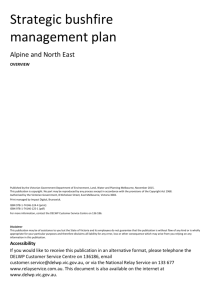
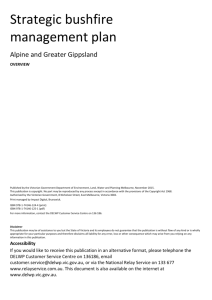
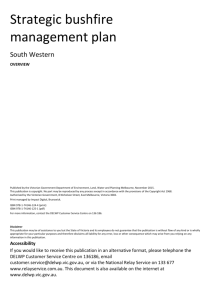
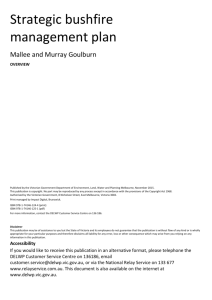

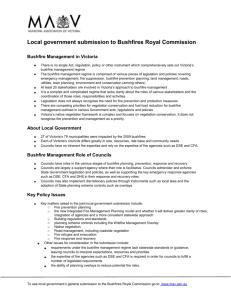

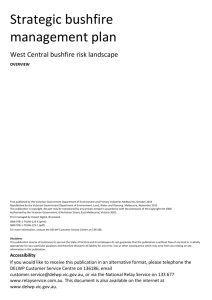
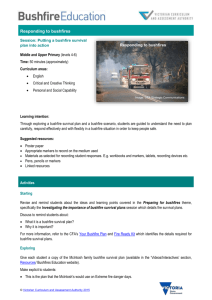
![Real-Life Bushfire Stories [WORD 515KB]](http://s3.studylib.net/store/data/006609571_1-2f8278fc8e104b25304174cf41f5494c-300x300.png)
